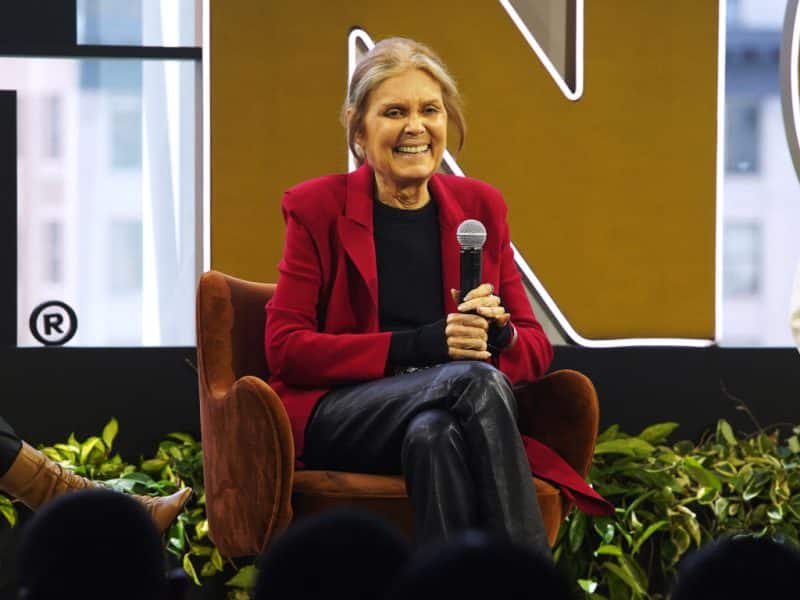

Credit: Courtesy of The World Economic Forum.
(WOMENSNEWS)–Many women find themselves in a Catch 22 after they receive the results of the $4,000 test and learn that they are carrying a faulty BRCA1 or BRCA2 mutation.
“They want to follow actress Angelina Jolie‘s example and have the same procedures she had to reduce the risk of breast cancer from 87 to 5 percent,” said Jen Flory, director of the Cancer Legal Resource Center. A joint program of the Disability Rights Legal Center and Loyola Law Center in Los Angeles, the center provides telephone assistance to individuals across the nation and cancer rights conferences.
“But they cannot afford to spend $100,000 or more on innovative techniques in prophylactic mastectomy, hospitalization, reconstructive surgery, medications, x-rays and other costs because they have no insurance or savings and are struggling to support their children or pay off education loans and other debts.”
She added that, “Until these barriers are removed, many women will get up every day and encounter the overwhelming fear that they face a 60 percent chance of developing breast cancer and a 40 percent chance of developing ovarian cancer in their lifetimes.”
Jolie, who earned $20 million in 2012, according to Forbes Magazine, didn’t reveal how much her double prophylactic mastectomy and other treatments cost or whether they were covered by insurance. In February, Jolie also had a breast reconstruction with an innovative nipple preservation technique, which ensures that the breast looks and feels natural.
Double Mastectomies in Preventive Role
Thirty-six percent of women who, like Jolie, carry the BRCA gene mutations had preventive double mastectomies in 2010. The National Cancer Institute reports that this procedure, which can cost $15,000 or more for the surgeon’s fee plus thousands more for hospitalization, is the most effective way of reducing risks.
Only 10 percent of women develop breast cancer after prophylactic mastectomy. Malignancies do occur because breast tissue is widely distributed on the chest wall and can sometimes be found in the armpit or as far down as the abdomen.
“No federal law mandates insurance companies to cover prophylactic mastectomies for high risk women,” said Flory in a phone interview. “Some states require insurers to pay the cost or will pay for preventive surgeries for women on Medicaid, the public insurance program for the poor.”
It’s not yet clear what the landmark Affordable Care Act will say about coverage of preventive mastectomy. The government is expected to issue guidelines on what constitutes “preventive services” in the next few months. Women who have questions should contact their health plan or their state insurance commission, or visit the U.S. Department of Health and Human Services website.
Some women end up paying the cost of preventive mastectomy out of pocket, rather than face a protracted battle with breast cancer that ends up in bankruptcy.
Breast cancer patients have a 2.9 percent risk of going bankrupt within five years after diagnosis and treatment compared to .28 percent of the general population, according to the Fred Hutchison Cancer Center in Seattle.
Other Measures
Women who cannot afford prophylactic mastectomy often opt for chemoprevention or add magnetic resonance imaging (MRI) to their regimen of mammography screening and clinical breast exams, noted Julie Eggert, a PhD and trained advance practice nurse who provides genetic counseling for patients at Upstate Oncology Associates of St. Francis Hospital in Greenville. S.C.
“Aggressive life style modifications can also decrease risk,” she said in a phone interview. “Increasing the amount of exercise, keeping weight under control and eating a diet rich in fruits and vegetables enables many women with BRCA gene mutations to avoid developing breast cancer for many years.”
Chemoprevention and MRI screening are less costly and less effective than prophylactic mastectomy, according to the National Cancer Institute. A generic form of the chemoprevention drug tamoxifen costs $100 a month; an MRI $1000.
The National Cancer reports that chemoprevention reduces the risk of developing breast cancer by about 50 percent among women who are at increased risk of breast cancer because of numerous factors, including the BRCA gene mutations.
The combination of MRI, mammograms and clinical breast exams discovered early cancers in 13.8 percent of women with BRCA gene mutations compared to 7.1 percent who received only mammograms and clinical breast exams, found a study in the March 28, 2011 issue of the Journal of Clinical Oncology.
“Discovering cancers in their earliest stages is important because they are the most curable then,” said Eggert.
Ovary Removal Option
Ovary removal in premenopausal women can be very effective in preventing breast as well as ovarian cancers. Jolie’s mother, actress Marcheline Bertrand, died of ovarian cancer at age 56 in 2007. Although there is no screening test for ovarian cancer, many younger women such as 37-year-old Jolie delay the procedure because ovarian cancer usually develops in the late 40s or 50s.
Breast reconstruction costs $10,000 or more. Thanks to the Women’s Health and Cancer Rights Act signed by
President Clinton in 1998, insurance companies that cover a mastectomy for prevention must also cover reconstruction surgery.
“The law doesn’t guarantee that the surgery be done by a world-renowned plastic surgeon who has pioneered techniques the patient wants,” said Flory. “Most insurance plans contract with certain plastic surgeons. But in rare instances, they will pay for other plastic surgeons if the woman can show that she requires a specific technique because of a medical condition.”
Jane Levy, the director of patient assistance programs at Cancer Care, urges women to work with their medical teams of physicians, nurses and social workers to identify sources of financial assistance.
“Physicians will sometimes lower their fees and hospitals may have special programs to pay all or part of other treatments,” said Levy in a phone interview. “Social workers are knowledgeable about Medicaid, the public insurance program for low-income individuals, as well as private foundations and companies, which have medication assistance programs.”
New York-based Cancer Care, a national, nonprofit organization at www.cancercare.org provides free professional support services for anyone affected by cancer. The American Cancer Society at www.cancer.org, Patient Advocate Foundation‘s Co-Pay Relief Program at www.copay.org and Facing Our Risk of Cancer Empowered (FORCE at www.facingourrisk.org) can also direct women to programs of assistance.
Sharon Johnson is a New York-based freelance writer.
Would you like to Comment but not sure how? Visit our help page at https://womensenews.org/help-making-comments-womens-enews-stories.
Would you like to Send Along a Link of This Story? https://womensenews.org/story/reproductive-health/130603/after-costly-cancer-gene-testing-treatments-add


